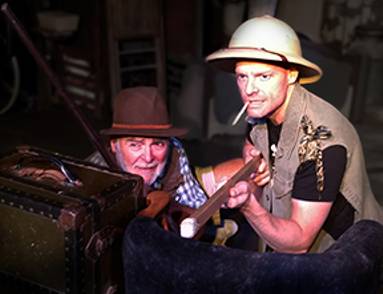by Jeff Grygny

James Pickering and David Sapiro
“Ephemerous, ephemerous,” the old actor mutters to himself.
Is it the spontaneous utterance of an existential feeling? Or did he want someone to ask him what he meant? The younger actor doesn’t ask— not even if he meant to say “ephemeris” (meaning “an almanac,” which doesn’t make sense) or “ephemeral” (meaning “insubstantial and transient,” which does). Anyway you look at it, the moment illustrates the ambiguity and impermanence of the actor’s art: that of summoning emotions, images and people out of the printed page and into warm, breathing life, repeated perhaps, but nevertheless disappearing, as Prospero said, “into thin air.”
It’s one of many such moments in David Mamet’s A Life in the Theatre, now playing at Bay View’s Alchemist Theatre. If you heard about Mamet’s ugly clash with the little company, you might be surprised that they dared to put on another of his plays: Mamet boorishly had their production of Oleanna shut down last year by lawyer’s order, because he didn’t approve of its cross-gender casting (where his scripts are concerned, he’s a strict originalist). But Mamet’s punchy masculine rhythms have always struck a chord with The Alchemist’s impresario Aaron Kopec. And anyway, when James Pickering mentions that he’d like to do a certain play at your theater, you’d be an idiot not to do it. Which is exactly how this show came to be. Pickering, a grand old man of Milwaukee theater if there is one, with time and inclination to do a two-man show on one of Milwaukee’s smallest stages, can jolly well just do that if he wants to. For local theater lovers, it’s an event not to be missed.
If a typical Mamet play is like an oil painting, all brash colors and deep shadows, this 1975 script, done at the time of “peak Mamet,” is like a watercolor. His usual macho head-butting is still here, but it’s muted into polite exchanges. What’s unsaid is more important that what’s said in these elliptical, banal, fragmentary conversations. There are the usual unfinished sentences and interruptions, and a bit of good old profanity as the play unfolds in a succession of short scenes that alternate backstage banter with clips from the amusingly wretched plays the two actors play in the course of their professional relationship. We witness offstage gaffes, blown lines, and wardrobe malfunctions—all minor hazards of the trade. It’s quite funny, in the way Larry David brought to Seinfeld and perfected in Curb Your Enthusiasm: brushed with embarrassment and melancholy.
Pickering’s Robert, the seasoned actor, is old school, full of protocol and superstitions. He often seems to be trying to pass something on to the younger actor, John, played by local favorite David Sapiro. But he seems express it only in potted analogies and zen-like aphorisms. Or is he just a mildly pretentious blowhard trying to impress the newbie with artsy mumbo-jumbo? On the other hand, John—is he really as receptive as he seems? Is he just being polite? Or is he biding his time until he can get something from the old man and move up? Is their seeming friendship real affection? Or simply affected? The play reminds us that actors are professional dissimulators: it’s their job to make the artificial seem authentic.
Director Jill Anna Ponasik heightens this sense, steering her actors towards naturalism: they could be playing themselves, for all we know. This results in a certain flatness—even when “acting” together, there’s little variation in characterization (with the notable exception of an over-the-top funny scene in a life raft, played in ripe English accents). Ponasik’s specialty is directing opera, and she creates a percussive between-scene score as the two men perform a dance dragging trunks, tables and chairs around with much banging and scraping. Impressive as this is, the novelty wears off pretty quickly, only to pique as some telling variation occurs. We see the theatrical season pass, measured in coats put on and taken off, makeup applied and removed, “goodnights” said, phone calls made— which builds up a sense of an actor’s life, layer by layer. In between there are moments of comedy and moments of shame; we wince for John when he flubs an entrance. An onstage meltdown over a missed cue is hilarious, but also heartbreaking, as we see the first rift in their cool but palpable friendship. As John piles up good reviews, Roger becomes more brittle. In one alarming scene he seems to have hurt himself— but is it a real crisis, or just a self-dramatizing attempt to win sympathy? The play gives us no clear answer. The final scene brings real comic pathos when Robert hides in the empty audience eavesdropping on John rehearsing a Shakespearian monolog.
The real play happens between the words. To the intent observer, Pickering and Sapiro create a feedback loop as their performances ambiguously inform and reflect each other, inducing a kind of vertigo, like two facing mirrors. Art is the mirror of life, it’s said. A Life in the Theatre reveals a world of uncertainty, reflecting reflections, and echoing echoes; like words written on water, ephemerous.
If plays are like drinks, this one is fine cognac: strong, smooth, and to be savored.
The Alchemist Theatre presents
A Life in the Theatre
by David Mamet
directed by Jill Anna Ponasik
playing through October 15th

first time seeing this one. one of the best i’ve seen at The Alchemist and now…one of my favorite plays.